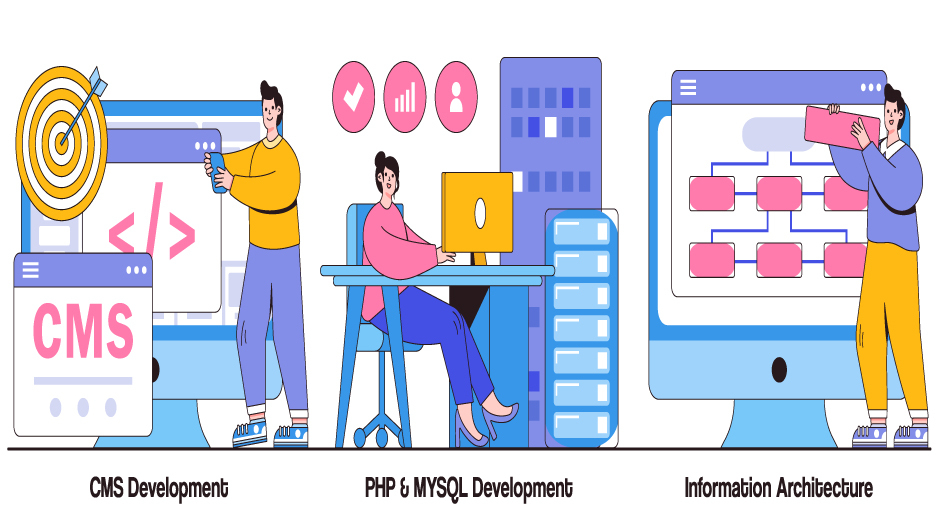One of the most well-known components of the contemporary big data system is the MySQL database management system. It is abundantly evident that anyone who is associated with enterprise data or general information technology should at least strive to have a fundamental knowledge of MySQL. MySQL is sometimes referred to as the most popular database, and it is currently enjoying extensive and effective use across all industries.
Even those who are not familiar with relational systems may immediately construct data storage systems that are quick, powerful, and safe when they use MySQL. In addition, the programmatic syntax and interfaces of MySQL serve as ideal entryways into the vast universe of other popular query languages and structured data storage.

Structured query language (SQL) serves as the foundation for MySQL, which is a Relational database management system (RDBMS) that was developed by Oracle. A systematic collection of data is what we refer to as a database. A simple grocery list, a picture gallery, or a location to store the massive amounts of information that are included within a business network are all examples of what could be considered anything.
To be more specific, a relational database is a digital storage that collects data and organizes it in accordance with the relational paradigm. Within the framework of this model, tables are made up of rows and columns, and the interactions between the various data pieces adhere to a highly structured logical framework. Simply put, an RDBMS is a collection of software tools that are utilized in the process of implementing, managing, and querying a database of this kind.
For the purpose of constructing and maintaining a wide range of software stacks, MySQL is an essential component. These software stacks include anything from customer-facing web applications to strong, data-driven business-to-business services. MySQL backends are utilized by internet-critical organizations such as Facebook, Flickr, Twitter, Wikipedia, and YouTube. This is due to the fact that MySQL is open-source, stable, and possesses a broad feature set. Additionally, Oracle provides continuing development and support for MySQL.
Advantages of MySQL-
SQL queries, which are based on the Structured Query Language, are the foundation of MySQL, which is a relational database management system (RDBMS). For the purpose of retrieving and managing the records included in the table, it is one of the most widely supported languages. Under the GNU license, MySQL is a piece of software that is both open-source and free. The Oracle Company is in favor of it.
The following is a list of the most significant characteristics of Linux MySQL:
- It is safe
A robust data security layer is included in MySQL, which serves to safeguard critical information from unauthorized access. In addition, MySQL uses encryption to protect passwords.
- Database management system that is based on relationships (RDBMS)-
The MySQL database management system is a relational database design. Accessing and managing the records of the table is accomplished through the use of this database language, which is based on SQL queries.
- No cost to download
Due to the fact that MySQL is free to use, we are able to obtain it from the official website of MySQL without incurring any costs.
- Simple in its operation
MySQL is a simple database management system. We are simply need to acquire a fundamental understanding of SQL. Simply utilizing a few straightforward SQL lines, we are able to construct and connect with MySQL.
- Quickness
MySQL is widely regarded as one of the swiftest database languages, as evidenced by the fact that it has passed a significant number of benchmark tests.
- Structure Based on Clients and Servers
Database management system MySQL operates according to a client-server architecture. The database server is a MySQL server, and there are an infinite number of clients, which are application programs, that interface with the server. These clients have the ability to query data, save changes, and other similar functions.
- It can be scaled up
MySQL’s ability to support multiple threads makes it one of the most scalable databases. It has the capacity to manage virtually any quantity of data, including as many as fifty million rows or even more. The default limit for the size of a file is approximately 4 gigabytes. On the other hand, we have the ability to raise this number to a maximum of 8 terabytes of data.
- Effective use of memory
The fact that it has a very low memory leakage problem contributes to its relatively high efficiency.
- Compatible with a wide variety of working systems
The MySQL database management system is compatible with a wide range of operating systems, including Novell NetWare, Windows Linux, numerous variants of UNIX, OS/2, FreeBSD, and other operating systems. MySQL makes it possible for clients to run on the same computer as the server or on a different machine. This is another feature that MySQL offers.
- Permits a rollback for
Transactions can be rolled back, committed, and crash recovery can be performed when using MySQL.
- Extensive adaptability
Due to the fact that it supports a huge variety of embedded applications, MySQL is a particularly adaptable database management system.
- Outstanding performance
MySQL’s storage engine architecture is what makes it faster, more dependable, and more cost-effective than other storage engines. It offers extremely high-performance results in compared to other databases, and it does so without sacrificing any of the software’s fundamental capabilities. It is able to load utilities quickly due to the different cache memory that it possesses.
- High levels of productivity
A higher level of productivity can be achieved by the developer through the utilization of Triggers, Stored Procedures, and Views from MySQL.
Important aspects of MySQL-
The MySQL database management system allows for the storage and retrieval of data across a variety of storage engines, such as InnoDB, CSV, and NDB. In addition, MySQL is able to replicate data and divide tables, which significantly improves both its performance and its durability.
Standard SQL commands are all that MySQL users need to know in order to access their data; they are not required to learn any new commands. MySQL is accessible and available on over 20 different platforms, including Mac, Windows, Linux, and Unix. It is written in C and C++, and it is accessible and available. The relational database management system (RDBMS) is capable of managing massive databases that contain millions of items.
Clients of MySQL can connect to the MySQL Server using a variety of protocols, including TCP/IP sockets, regardless of the platform they are running on. As an additional feature, MySQL is compatible with a variety of client and utility programs, as well as command-line programs and management tools like MySQL Workbench.
The workings of MySQL-
A client-server architecture is the foundation of MySQL. MySQL server is the central component of MySQL; it is responsible for managing all of the database instructions. In addition to being a library that can be incorporated into distinct applications, MySQL server is also available as a standalone software that can be utilized in a client-server networked context.
There are a number of utility programs that are used in conjunction with MySQL to provide support for the management of MySQL databases. MySQL server receives commands through the MySQL client, which is a software application that is installed on a computer. When it was first built, MySQL was designed to manage huge databases in a rapid manner.
MySQL is able to transfer the database to numerous locations, despite the fact that it is normally installed on only one machine. This is because users are able to access the database using a variety of distinct MySQL client interfaces. The SQL statements are sent to the server by these interfaces, which then display the results of the statements.
Compatible with a variety of different services-
MySQL was created with the intention of being interoperable with other systems. Deployment in virtualized settings is supported, including Amazon RDS for MySQL, Amazon RDS for MariaDB, and Amazon Aurora for MySQL, among others.
Through the utilization of database migration tools such as the AWS Schema Conversion Tool and the AWS Database Migration Service, users are able to migrate their data to a SQL Server database. Although SQL Server and MySQL share some similarities, the semantics of database objects are not identical between the two.
While migrating from SQL Server to MySQL, it is necessary to take into consideration the architectural differences between the two systems. MySQL does not differentiate between a database and a schema, but SQL Server sees the two as distinct entities. MySQL is a relational database management system.
Why Does It Matter for Website Design?
The significance of MySQL in website creation should be quite obvious. MySQL controls how quickly pages load on your website and how quickly you can retrieve data that has been stored. It is an essential component of website design because it directly affects the performance of the site. In addition to making, it more difficult to locate the information you need, an unoptimized database might cause duplicate data to take up more space on your website and eventually slow it down.
You won’t often need to take any action to maintain the database’s health. On the other hand, knowing when anything goes wrong will make troubleshooting easier and faster. For this reason, a lot of engineers will make use of a tool that gives them real-time access to all database requests. In this manner, the developer can determine the root of the problem as soon as a request fails. In conclusion, MySQL enables users to identify issues with the database and enhance website load times overall.
Conclusion-
The MySQL database management system is frequently utilized in the field of web development for a variety of purposes, including user authentication, content management systems, e-commerce websites, and data-driven web applications. For the purpose of storing blog posts, user information, and comments, a blog platform might make use of MySQL. The PHP code is able to retrieve the pertinent data from the MySQL database and show it on the web page whenever a visitor visits the website.


